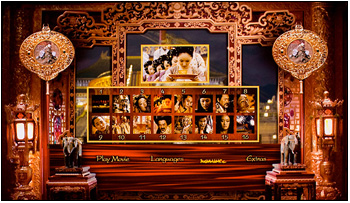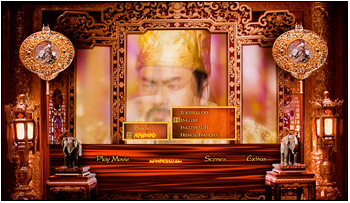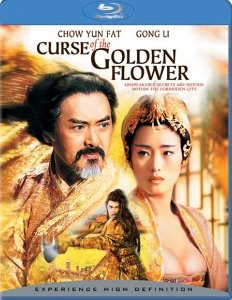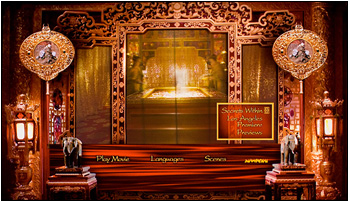Zhang Yimou has made something of a splash with Western
audiences in recent years: first (and best of the three, in my opinion)
with the politically controversial
Hero in 2002, starring Jet Li, Tony Leung Chiu Wai and
Maggie Cheung; then two years later, the romantic
House of Flying Daggers, with Zhang Ziyi, Takeshi Kaneshiro
and Andy Lau; and now, less successfully by most accounts, with the
extravagant
Curse of the Golden Flower, featuring Chow Yun-Fat, the
charismatic star of Crouching Tiger, Hidden Dragon and many a
Hong Kong gangster film, and the radiant Gong Li, Zhang Yimou's
discovery twenty years ago when they made their first six feature films
together.
All three films continue to exemplify Zhang’s fascination with
color schemes, and all of them involve secrets – secrets between the
characters as well as from the audience. While the action of Hero is
extroverted, the motivations and true intentions of its characters are
kept covert; there is even a kind of
Rashomon-like quality to the narrative. The intimate secrets
of
House of Flying Daggers are kept from the audience to the
point that we, along with its protagonist, may feel we have been
tricked. Curse of the Golden Flower, obsessed with the
discrepancy between opulence and loneliness, is layered with secret
plots – plots to poison, to overthrow, to love.
While all three films have a love story of one sort or other at their
core, there exists also a conflict of obligations - a common theme in
Asian stories from Chushingura to A Better Tomorrow.
In Curse, the love stories, such as they are, are
subverted, infected and distorted by conflicts of loyalty to the point
that love is not really possible, only the manipulation of others to
insidious and malicious ends. It is here that the film reveals its most
exquisite dramatic textures – all in the context of blinding color and
opulence: the brilliance of the gold and glass blinds and binds everyone
to their fates, which are, for each of them, inescapable. To the extent
that Curse has a weakness, it may lie in our lack of interest in these
love stories for lack of development, even if consistent with character.
Curse of the Golden Flower invites comparisons, not only to
Zhang's two previous films, largely because of his use of color and
their spectacular set pieces, but to Shakespeare, most obviously King
Lear. The motivations of the three sons, however, are rather different,
as is the king's, and are complicated by maternal loyalty, or incest, or
both. And Emperor Ping, of course, is anything but feeble. Have no
doubts, however, about the level of carnage by the movie's end. Were
Richard III, Macbeth or Lear any less?
Whether you warm to its intrigues may depend on how well you can accept
Curse of the Golden Flower as grand opera or, at least,
grand soap - told with a dedication to visual detail reminiscent of von
Sternberg's
Scarlet Empress. The lavish sets make the discrepancy
between opulence and rottenness all the more fated – an essay on the
corrupting influence of absolute power. Curiously, while each character
seems to have absolute power - within the bounds of their fief – they do
not appear to have choice. Whether they be cooks or princes, doctors or
generals, they accept neither their place nor their limitations, which
is what makes their story, our story.
As with
Hero and
House, the
acting talent is top drawer, especially Gong Li, who alternates disdain,
shame, disgust and seething passion in a walking disaster waiting to
explode – a tour de force of controlled emotion that makes her omission
from the list of last year’s nominees as surprising as it was
regrettable. The final set piece with its rows of disciplined soldiers,
extending, it seems, to infinity, reminiscent of the attack on the
Caligraphy School in
Hero, is truly jaw dropping. We can’t help wonder if these
are real people or CG simulations. The effect is as seamless as it is
brilliant in execution. The entire production design, as with Hero and
House: the sets, makeup and costumes, and use of color is something to
write home about. In contrast to
Hero and
House,
one color predominates in
Curse of the Golden Flower: Gold. And, in strong contrast to
House,
Curse is photographed mostly in deep focus with a clarity
that boggles the eye. The images are in artful exercises in precision,
even at night: the exteriors, rich with saturated color; the interiors
glowing with dazzling, overpowering brilliance. It is no wonder that all
who enter the palace are obsessed to the point of madness, living in
such a blinding, claustrophobic environment.
 |
The Score Card
The Movie : 7.5~8.0
The fictional events take place in the prosperous Tang Dynasty over one
thousand years ago. The emperor has three sons, the two younger ones by
the present empress; the eldest by her predecessor before he became
emperor. The eldest, we learn from the outset has been intimate with his
stepmother for three years, during which time his next younger brother
has been away and is now returning in time for the Chrysanthemum
Festival, which will figure prominently at every possible layer of
meaning and plot. (By the way, it must be that all the titles were
already taken, for while the golden flower figures into the story, the
notion of a "curse" does not. This is, after all, not a Boris Karloff
horror movie. "Fate" would have been a better word.) The eldest son is
weak and explicit about his lack of interest in assuming the throne at
the appropriate time. The middle son is evidently the most loyal and
most competent. The youngest lurks in the background. He is attentive,
but we are unclear about his intentions. The empress has been very sick
for days. She is commanded to take a medicine designed by the king. It
is not difficult to suspect foul play. All this in the first 15 minutes.
The rest of the movie plays out the inevitable drama – and it’s a
killer.
Image : 9.0
In my travels among BD discs, I have yet to see a film that shows off
the advantage of Blu-ray over a good standard definition presentation as
well as this one. It appears to be transferred from the same high
definition master that produced Sony's Region-1 SD release of
Curse of the Golden Flower, which I would have given about a
6.0 score at best. But the Blu-ray is another matter entirely. I saw
this movie theatrically and was unimpressed by the image. The garish
color and the brilliance of its intensity seemed to overwhelm the
projector’s ability to make any sense of it. I had hopes for the
SD DVD, and indeed
Sony's R1 was an improvement in terms of contrast control; but
the detail and resolution necessary to keep our attention from wandering
was still missing. The problem with the SD, or any 480p attempt at this
movie, is that there is simply too much fine detail, especially in the
background, for it to get a proper handle on. Shown in full 2.35:1
aspect ratio, the textured costumes, the palatial ornamentation, and
especially the illumination that exudes from the walls in reds, purples
and yellows positively bursting with energy, is in control and evident
only in high definition. Our eye can scan any surface at its leisure and
take in the full impact, or we can relax in confidence and give
ourselves up to the image. There is only a fine sense of grain that can
be seen most of the time, but it never imposes itself. I can imagine
that a properly duped and projected film would have done a slightly
better job, but I certainly wasn’t privy to such, nor can we really know
what was on the final film before it was presented for HD mastering or
theatrical duplication. What higher praise than that this Blu-ray DVD is
better than the theatrical presentation!
Empathy : 9
Because the image is so immaculately and deliciously manifest, we are
free to experience the drama without concern or critique. That said, we
can’t help but be impressed by the magnificence of Zhang’s conception
and the dedication his team had in realizing that intent. Some will no
doubt feel that the technique overpowers the drama, and it might take a
few viewings to place the visuals in perspective.
Audio & Music : 9/7
Mostly, fabulous. On 2-channel PCM mixdown, the music, sound effects
were clear, with plenty of bass and impact. The various effects, precise
and telling. The dialog in classic Mandarin was articulated with the
necessary finesse, even when other sounds were in the foreground. I read
many complaints that this was a noisy movie, so I decided to play the
audio while I tinkered elsewhere about the house. Contrary to an
oft-held opinion, the movie contains a number of long, delicate, nearly
silent passages. It's pretty much only in the last scenes that Zhang
pumps up the whomp and clatter. I thought the music score started off
well, but devolved into unimaginative cliché at times when the armies
attacked the palace. And, since we are naturally affected by the last
thing we see and hear in a movie, what could have possessed the American
distributor of this film to retain a mood-disrupting and (to this ear)
utterly inappropriate Chinese pop song (which, in a different context,
would be quite pleasant) as the exit music over the final credits.
Operations : 8
The Main Menu can be accessed quickly enough after loading by pressing
"next chapter" after the blu-ray promo begins. There are only 16
chapters with thumbnails that suggest the scene well enough, except that
there is no thumbnail to indicate the attack on the doctor's camp
outside the castle, a curious oversight. Subtitles are in white, though
in this case, I think I would have preferred yellow. Since white is not
a part of the color scheme, white is a bit jarring. On the other hand,
the dialog is placed below the frame where possible, so it's not always
intrusive. One other oddity: The main menu is first announced (but not
on successive attempts during play) by a pair of sliding doors which two
silhouetted figures open from behind. (The
SD edition goes directly to a figurative panel within which are
seen dramatic scenes from the movie.) While, at first blush, the sliding
panels idea seems clever, I thought it is not especially Chinese as much
as it is Japanese; at any rate, there are no such scenes in the movie.
In fact, one of the most elegant things about the set design is how
various chambers are created by raising and lowering translucent blinds.
Extras : 7
The principal Extra is a self-promoting and generally repetitive 22
minute 480p letterboxed thing titled "Secrets Within,"
from which we gather that “every effort was made to get the details of
the period correct.” How they know this I haven’t a clue but I’m happy
to accept the movie as a cinematic rendering of what Tang splendor may
have looked like or as complete fiction. Matters not.
 |
 |
 |
 |
|
|
|
LensViews
July 1st, 2007
Pirates of the Caribbean: Curse of the Black Pearl
Pirates of the Caribbean: Dead Man's Chest
Curse of the Golden Flower
The Searchers
The Queen
Unforgiven
Casino Royale
Enter the Dragon
Kung-Fu Hustle
Rocky
Reds




